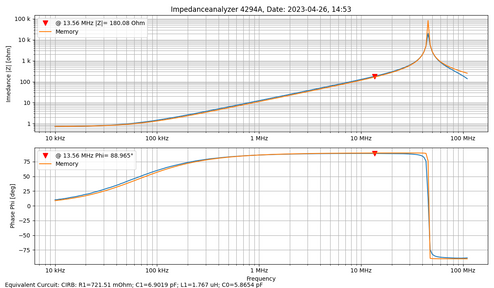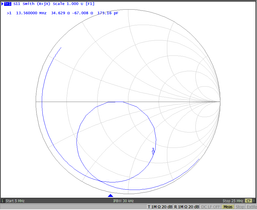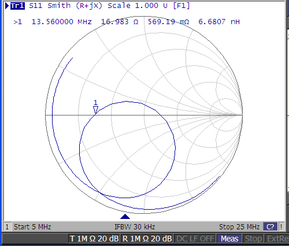- Forums
- Product Forums
- General Purpose MicrocontrollersGeneral Purpose Microcontrollers
- i.MX Forumsi.MX Forums
- QorIQ Processing PlatformsQorIQ Processing Platforms
- Identification and SecurityIdentification and Security
- Power ManagementPower Management
- Wireless ConnectivityWireless Connectivity
- RFID / NFCRFID / NFC
- Advanced AnalogAdvanced Analog
- MCX Microcontrollers
- S32G
- S32K
- S32V
- MPC5xxx
- Other NXP Products
- S12 / MagniV Microcontrollers
- Powertrain and Electrification Analog Drivers
- Sensors
- Vybrid Processors
- Digital Signal Controllers
- 8-bit Microcontrollers
- ColdFire/68K Microcontrollers and Processors
- PowerQUICC Processors
- OSBDM and TBDML
- S32M
- S32Z/E
-
- Solution Forums
- Software Forums
- MCUXpresso Software and ToolsMCUXpresso Software and Tools
- CodeWarriorCodeWarrior
- MQX Software SolutionsMQX Software Solutions
- Model-Based Design Toolbox (MBDT)Model-Based Design Toolbox (MBDT)
- FreeMASTER
- eIQ Machine Learning Software
- Embedded Software and Tools Clinic
- S32 SDK
- S32 Design Studio
- GUI Guider
- Zephyr Project
- Voice Technology
- Application Software Packs
- Secure Provisioning SDK (SPSDK)
- Processor Expert Software
- Generative AI & LLMs
-
- Topics
- Mobile Robotics - Drones and RoversMobile Robotics - Drones and Rovers
- NXP Training ContentNXP Training Content
- University ProgramsUniversity Programs
- Rapid IoT
- NXP Designs
- SafeAssure-Community
- OSS Security & Maintenance
- Using Our Community
-
- Cloud Lab Forums
-
- Knowledge Bases
- ARM Microcontrollers
- i.MX Processors
- Identification and Security
- Model-Based Design Toolbox (MBDT)
- QorIQ Processing Platforms
- S32 Automotive Processing Platform
- Wireless Connectivity
- CodeWarrior
- MCUXpresso Suite of Software and Tools
- MQX Software Solutions
- RFID / NFC
- Advanced Analog
-
- NXP Tech Blogs
- Home
- :
- RFID / NFC
- :
- NFC
- :
- Re: PN7160 Reader function do not work at low temperatures (matching)
PN7160 Reader function do not work at low temperatures (matching)
Hello,
my name is michael and i am working on a project with the PN7160 with asymmetric antenna tuning.
At normal room temperature, the reader mode works very well at a range of up to 40-50mm without reading errors. But as soon as the temperature drops below 0°, communication (with the card) abruptly stops. Not only lower range but completely. However, the NFC field is still present (at 13.56MHz). When the temperature rises again, the whole thing starts to work again.
The problem is due to the temperature of the matching circuit or the PN7160, not the temperature of the antenna itself (tests with cooling spray).
The capacitors used are NP0/CG0, the inductors MLJ1608 chip inductors, all 0603.
Our antenna parameters:
1.76uH / 6.9pF / 720mOhm
Matchingcircuit (asymmetrical tuning):
We calculated these values with the formulas / NXP tools and get very good results (but only above 0°C):
160nH / 330pF, C1 = 56pF, C2 = 76pF, Rq = 3.3R.
(instead of 56pF/76pF we also tried with 60pF/80pF, with the same result).
We have also done a tuning by Smithchart. Interestingly, the whole thing seems to be quite detuned with the above values, but still works well.
If we then tune the matching to a more optimal Smithchart result, the function drops (range drops, read errors, tests at room temperature).
(C1 = 56pF, C2 = 60pF)
Is there something specific we should look into to find the problem in low temperatures?
Thanks in advance!
many greetings,
Michael
已解决! 转到解答。
Hello Alb,
Please try the following:
Try to reduce the gain to 39dB or 32dB and check the performance.
See an example for Type A
BR
Tomas
Dears,
any news? We reduced the Q and cheked the receiver voltage (under 1.6Vpk) but nothing changed. We have tested two identical boards: only one works under zero degrees (-5°C). We moved all the output components (filters, matching,...) from one board to the other and the working one still works and the not working still doesn't work so it seems that it isn't a metter of passive components.
All the "defective" boards were cooled @-5°C. We put the boards at room temperature and they don't work but restart to detect nfc after 20-30sec when they warn a little bit.
Hello Alb,
Thanks for your feedback!
Could you "Dump" the RF settings from the functional and non-function boards and share them with us, please?
We think that the issue is caused by noise on Rx lines. This could be eliminated by adjustment of the CLIF_ANA_RX_REG register -> PN7160 RF settings guide -> 3.4.7
BR
Tomas
Hi Thomas,
all the boards have the same dump (see attached file). We reduced gain to 39dB and it works at -5°C but detecting distance is very short. 44dB seems a good compromize. I have a question about rf setup. Before your suggestion we didn't set gain and the dump value is 0x66 (default?): is there a doc where I can find all registers default value? There a lot of registers that are not set in rf setup and we would like to be sure that they have a default and known value.
Thanks
Alberto
Hi Tomas,
I saw the optimized parameters table in the faq but I can't set hundreds of registers....
A lot of values are the same I have in my dump so I suppose that are defaults because I never set them in my configuration. I need to know which is the standard config of a device that comes out from nxp so I can set only the registers that are different with respect to default and are required by optimized configuration reported in table 12 of AN13892.
Thanks
Dears,
we have the same issue on PN7160. All the boards are really sensitive to temperature changes: they works well at room temperature but near 0°C and 50°C we cannot detect any tag (device answer is "60 07 01 a1" as reported above).
Is there any update about this topic? We are really interested in what you suggested as a solution.
Thanks and regards
Alberto
Dears,
we have the same issue on PN7160. All the boards are really sensitive to temperature changes: they works well at room temperature but near 0°C and 50°C we cannot detect any tag (device answer is 60 07 01 a1 as reported above).
Is there any update about this topic? We are really interested in what you suggested as a solution.
Thanks and regards
Alberto
@michael_d_1983 and @Tomas_Parizek
I have been asked by Nadia to jump in this brainstorming. Please find here my 2 cents.
First of all, i would try to reproduce this behavior (using freezing spray) directly using my OM27160B1 Arduino board connected to LPC55S69 EVK board (running polling example as @michael_d_1983 mentioned before).
Main reason is that i ignore the quality of the passives (dumping resistors, caps, inductor and crystal) and quality of the pcb that Fronius has chosen for your own PCB. If passives caps, dumping resistors and inductor have high temp drift, then "mistuning" is a result of an integral of different sources and we will simply get lost.
I offer to inspect your Fronius hardware at my lab (i have miniVNA too). So, feel free to ship following HW to my NXP address:
1 sample of your PN7610 equipped board (are you using I2C version or SPI version), including detailed connections and attached wires (i should solder all relevant signals to my Arduino adapter board).
1 sample of small area token (the one that fails at your target read range)
1 sample of ID1 card
1 complete bill of materials file.
nice to have: if you could ship a complete working NFC reader, including MCU, just executing a polling function, with possibility to monitor via Putty/Teraterm, or even just a led that blinks when a successful reading takes place, then i could monitor impedance matching under frozen temperature and room temperature, and measure EM field strength under both conditions.
If you just want to compare the quality of BOM passives that NXP has adopted, just see description of our demoboard BOM (included in this zip file HW6635.zip\SCH-47941\SCH-47941_A1.BOM) available in nxp website. In all this analysis, we are not considering if adopted Crystal has any temperature drift, so it would be good also to compare your BOM with our Demoboard BOM.
and depending on passive-temp drift effects, i would try to "tune circuit" to an average real part of input impedance good to interact with token (worst case scenario) both at low temp as well as room temp.
Let me know if this sounds reasonable to you.
Cheers
Rodolfo
(please provide Fronius email address so that i can inform my NXP shipping address in Roma - Italy)
Hello Michael,
Ok, got it ! We tested the PN7160 dev. kit with freezing spray on our side as well and We can not reproduce your issue.
We think the issue will be related to the matching itself. It is very strange that you see the performance drop with more optimal matching.
What is the current consumption (VBAT or VDD(UP) for the "optimal" tuning? Is it below 250mA?
Did you follow the antenna matching guide, especially the calibration part ?
Also, one thing which could affect the Reader's behavior is the wrong setting of Dynamic power control. Can you disable it in the following way, please?
uint8_t NxpNci_CORE_CONF_EXTN[]={0x20, 0x02, 0x5F, 0x02, /* CORE_SET_CONFIG_CMD */
0xA0,0x40,0x01,0x00, /* TAG_DETECTOR_CFG */
0xA0,0x0B,0x57,0x10,0x10,0x90,0x72,0x0F,0x4E,
0x00,0x3F,0x95,0xB7,0xAA,0x3F,0x9F,0xA7,0x99,0x52,0x9F,0x97,0x99,0x5B,0x9F,0x97,0x99,0x5D,0x9F,0x97,0x00,0x66,
0x9F,0x07,0x00,0x68,0x9F,0x07,0x00,0x72,0x9F,0x07,0x00,0x75,0x9F,0x07,0x00,0x7D,0x9F,0x07,0x00,0x7F,0x9F,0x07,
0x00,0x88,0x9F,0x04,0x00,0x8A,0x9F,0x04,0x00,0x93,0x9F,0x04,0x00,0x95,0x9F,0x04,0x00,0x9E,0x9F,0x02,0x00,0xA6,
0x9F,0x00,0x00,0xAB,0x1F,0x00,0x00,0xB5,0x1F,0x00,0x00,0xBE,0x1F,0x00,0x00
BR
Tomas
Hi Tomas,
I have now performed 2 things:
* Lowered the TXLDO to 3.9V on the "optimally matched" circuit, which now gives us good results at room temperature. The current was indeed a little too high, I have not yet measured the new current.
* Disabled the DPC according to your settings. I thought that the DPC is disabled by default, isn't that so?
It feels like it works a bit better now, e.g. the card is still recognized at a few minus degrees, albeit with very limited range, but the token is not.
The goal would be a function for card and token at minus 25°C.
Where else can we start? Increasing / decreasing Q?
By mistake we put in the NxpNci_RF_CONF[] settings from the Evalboard, no idea how that is to undo and if it has influence.
We have calibrated the VNA before each measurement.
Regards,
Michael
Dear Michael,
Thanks for your reply!
Could you enable the "NCI_DUBUG" as shown below, please? And then share the log file again. It should give us more information about what is happening.
BR
Tomas
Hello Tomas,
thanks for your reply.
The NCI_DEBUG switch was enabled (NCI_DEBUG enables the messages beginning with NCI << .... messages, there is no more additional logging information in the library).
You can find the logfile with the NCI debug logs in the file PN7160-LOG.txt which is included in the rar file of my previous post and additional added here.
Thanks & Regards,
Michael
Hello Michael,
Can you check the following, please?
- Does the "detuned" circuit work below 0°C or not?
- Can you share a Smith chart before and after "cooling" by the spray? I would like to see if there is any change in the matching.
- Could you measure VDD(UP) Current for the "optimal" matching for continuous RF Field ON?
- What power supply are you using for VDD(UP), 5V or 3.3V?
- Can you share your configuration file libnfc-nxp.conf with us, please?
- Can you enable and share the "logs" where we could see what happens during the communication, please?
-
Inside libnfc-nxp.conf please set the next log levels to 0x03:
NXPLOG_EXTNS_LOGLEVEL=0x03
NXPLOG_NCIHAL_LOGLEVEL=0x03
NXPLOG_NCIX_LOGLEVEL=0x03
NXPLOG_NCIR_LOGLEVEL=0x03
NXPLOG_FWDNLD_LOGLEVEL=0x03
NXPLOG_TML_LOGLEVEL=0x03 - Then start e.g. the polling loop
-
Best Regards
Tomas
Customer Application Support Engineer
Hello Tomas,
thank you very much for your very quick reply and sorry for my late.
The power supply for TVDD is 5V, we also tried to configure the TXLDO to lower values, but that did not bring any improvement.
We are using the embedded library (PN7160 NXP-NCI MCUXpresso Example Project) from the NXP site. Firmware version of PN7160 is updated to 12.50.06
The "detuned" circuit does not work at below 0°C either, neither does a configuration with "symmetric matching" which we tried.
I have made the attached measurements in 2 configurations:
* The values calculated with the NXP tools which work well at least at room temperature
* The values matched using a VNA Smithchart, which do not give such good results
When cooling with cold spray, I could not observe any change in the smithchart, also the current at RF-ON seems unchanged.
Approaching an NFC card or a token changes the smithchart strongly.
I have also attached the log file, here I noticed the following:
NCI << 60 07 01 a1 <- These packets are received cyclically from PN7160 after cooldown until he detects the card again. I never noticed these packages in normal operation.
Thank you very much and kind regards,
Michael
Hi,
@michael_d_1983 @renkebienert @Tomas_Parizek @Alb
i just condensate here some hints provided by Renke during teams call on 15/05 from 9 to 10AM.
1) assumption that matching design is the source of temperature variation
2) if adopted inductors have ferrite and 1) is aiming high output power design, then recommendation is to avoid using inductors with ferrite (since they saturate with high current and effects are not visible during static input matching measurement with VNA)
3) Renke suggested to increase a bit input impedance to remove ambiguities (like possible saturation). At least, making a higher real part of input impedance to check if sensitivity stays. Also, directly using freezing spray can easily go to below limits of NFC controller. Also moisture problem can cause 'unforeseeing humidity and conductive effects which might exceed silicon limits'.
Reply to 3): Fronius has done tests in temperature chamber with controlled temperature and moisture concentration.
NXP brainstorming:
A) Is it crystal that fails at low temp? Not true because RF ON stays even when performance drops. If crystal stops, there is no RF field, so A) can be excluded.
B) Card works as expected, so problem is on reader side: data generation fails, which less likely to happen since digital/modulation part has been qualified for low temp limits.
C) then by elimination, the only possible source is on analog part, which we might divide in 3 sources:
C1)matching tuning part. Ferrite inductors might be source.
C2) there could be a timing issue during low temp.
C3) Something is wrong with the Receiver part. If C3 is the source, then it would be a good test to check voltage variation while temp is changing. It is possible that Receiver input might be current overdriven at low temp. Currently Receiver series resistor is 3300 ohm; Renke suggests to increase resistors to 20k to understand if PN7160 still can detect cards. Then redo the test a low temp. Checking pulse shape to assess overshoot and undershoot which might jeopardize communication.
As summary it is necessary to hunt the source.
a) Action point replace ferrite inductance with normal inductance of same value. propose to increase dumping resistors low down a bit Q factor. Fronius already did such changes ( dumped Q); design have worked only above or equal to zero degrees, but not under-zero temp).
b) replace receiver resistors with higher values to avoid RX clipping effects of PN7160 receiver part.In Fronius measurement is already 2 Volts although suggestion is to keep below 1.6 Vpk.
c) use proper oscilloscope probing to assess pulse shaping.
Your comments are welcome.
Cheers
Rodolfo
We're having the same issue, particularly at low temperature. Using some tape I have masked off the PN7160 and all the RF side so I can cool only the crystal and its caps ( with freezer spray ) and that seems to have the same effect i.e. works at room temperature but not cooled. Some units are less affected than others.
When removing from a domestic fridge and looking at the board with a thermal camera, there's a slightly warmer spot on the crystal and so I'm assuming that it is being overdriven; quartz crystals are more efficient at lower temperatures.
I have tried a _very_ wide range of caps [for the crystal / Piece oscillator] however that appears to make little difference to the cold performance.
At the moment I'm playing with the XTAL_SETTINGS_CFG to see if that makes any difference.
Hello Michael_W,
Can you check the RF field, e.g. NFC Polling ? Once you apply the freezing spray, do you still see NFC polling ? Or are some NFC polls "missing" ?
Thanks!
BR
Tomas
Many thanks for your response Tomas. You could probably say 'I told you so' regarding the matching network: after messing with the XTAL caps and settings, with little evident change, I tried some alterations to the matching network - namely increased Rrx to 3k3 from 1 k ( I'll check why the designer chose these values ) reduced Crx from 10 nF to 1 nF and altered the type of Lo to wirewound from ferrite.
We don't have a VNA here so we've just used the reference design as far as I'm aware. This seems to have improved the response - after a night in the fridge here it still works, which it didn't before. I'll take it home along with the 'scope and see what happens after a night in our freezer.
In answer to your question - no. I've attached some pics - the short regular burst is seen at room temperature and the one with the updated matching circuit with freezer spray. The longer regular burst is with the previous matching components and freezer spray. There's also a pic of my coupling - an empty board with a crude coax tacked onto the antenna points and held a short distance away.
I'll report back here on my findings with the freezer.








